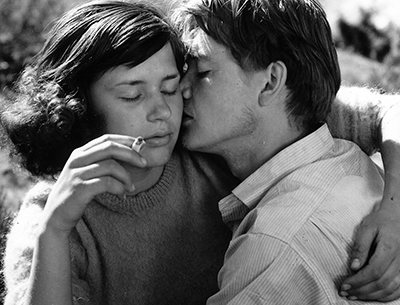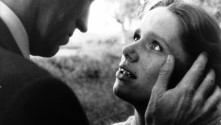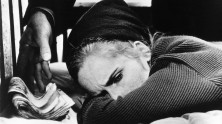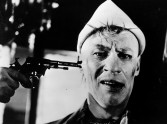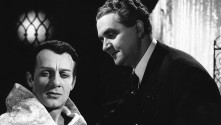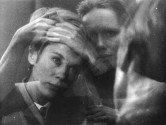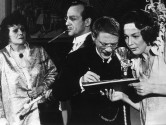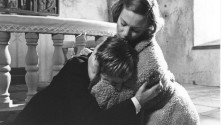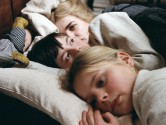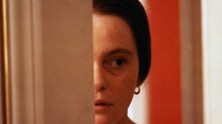
Darkness Unto Light.
The Cinema of Ingmar Bergman
Of all the iconic images that Ingmar Bergman forged in his long career, the one that sits in the public imagination most potently as a totem of his imposing, death-obsessed oeuvre is that of Bengt Ekerot’s pasty grim reaper staring down Max von Sydow’s dumbfounded knight on a stygian coastline sometime after the sputtering of the Crusades in The Seventh Seal, his arm outstretched to reveal the great black expanse of his shawl and his stark expression all but ensuring an unfortunate verdict. As a composition, it is formidable, and as an encapsulation of the confrontational directness with which Bergman’s films tackle mortality and other unpleasant human inevitabilities, it’s hard to beat. But another image from later in the same film, equally as unforgettable, manages to better distill the complex weave of contradictory feelings that his films evoke—the idea that in death and illness and madness there is also always humanity and light and memory. That, of course, would be the money shot in the film’s coda, a distant sunset view of silhouetted figures passing from one life to the next atop a hill, not trudging to their demise but dancing, hands interlocked.
Such evocations of communal solidarity are rare in Bergman’s ruthlessly combative world, and so it’s fitting that this particular shot occurs in a liminal state beyond the narrative proper. With that said, Bergman’s characters, however wracked with doubt and despair they may be, could almost never be accused of apathy or complete surrender, and the crucibles they endure in pursuit of connection or just basic contentedness echo those of the filmmaker himself, whose six decades of cinematic production demonstrate a man fiercely contending with his demons through his art, occasionally pulling ahead and locating beauty if only to be dragged down yet again. That his drive to create never ceased in the face of lifelong depression, myriad divorces and other family trials, and unsympathetic critics is one of the prodigious accomplishments of film history. A diligent cinephile could reasonably expect one or two Bergman films a year throughout the second half of the 20th century, a level of sustained productivity matched in the realm of world-class auteurs only by Jean-Luc Godard and Alain Resnais.
Much as this perseverance can be accredited to the mettle of the artist himself, to a large extent it was also enabled by Bergman’s peculiar and privileged position as a serious-minded arthouse filmmaker who commanded an unrivalled degree of industry cachet in his native Sweden throughout his career. Bergman’s professional life began in the theater shortly after his studies at Stockholm University, where he built an early reputation for his managerial competence and skill with actors that would pay off later in his ascent to the role of director at the Royal Dramatic Theatre (1960-66). He would remain a fixture there for the rest of his life, securing a position at the forefront of Sweden’s cultural elite, but it was in his breakout years of stage production that he attracted the attention of Svensk Filmindustri head Carl Anders Dymling, who recruited him as a scriptwriter in 1943. Three years later, he had logged his first directing credit with the female-fronted social drama Crisis—hardly a quintessential Bergman film, but one with a then-novel degree of intimacy and enough visual panache to excite the industry gatekeepers.
Bergman’s real breakout came in 1953 with Summer with Monika, a modest coming-of-age drama marketed as an erotic escape in America despite its sensitive, sobering treatment of sex and the rude awakenings of adulthood. With the help of a ringing endorsement from Godard (“the most original film of the most original of directors”), Monika inaugurated a decade of seminal works, each propelling Bergman further into the international spotlight. Smiles of a Summer Night, a lithe romantic roundelay voluptuously photographed both in studio and on location by Gunnar Fischer, exposed the director’s knack for spiking comedy with misery. The Seventh Seal, an allegorical historical fantasy that sets its sights on the meaning of life, cemented his audacity. Wild Strawberries, a touching elegy for old-age regrets, exhibited a panoramic maturity. And The Virgin Spring, a snapshot of Sweden’s heathen period, spotlighted a willingness to challenge with extremes of formal austerity and grim subject matter.
If the fifties established Bergman as an artist, though, the sixties laid bare his soul. In a pair of trilogies, the filmmaker increasingly honed a spare, elemental style to tackle questions of God’s existence or lack thereof, man’s moral complicity in cycles of violence, and the inability of humans to relate to one another, all filtered through narratives of almost painful psychological intimacy. It was in this period that he secured a stable of collaborators that would come to define the Bergman brand: cinematographer Sven Nykvist, script supervisor Katinka Faragó, costume designer Mago, and, most importantly, actors Liv Ullmann, Max von Sydow, Bibi Andersson, Gunnar Björnstrand, Harriet Andersson, Erland Josephson, Ingrid Thulin, Gunnel Lindblom, and others. Bergman became known for an alternately demanding and tender manner on set, with few thespians leaving an experience under his tutelage without citing some episode of bullish authoritarianism, and even fewer without touching on the deep trust and self-confidence he instilled in them. Uncommonly revealing and lengthy close-ups, the director’s celebrated aesthetic forte, were used as tools for breaking down a performer’s defenses as well as vessels for the inner spirit, and no actor left Bergman’s grip without one.
The sixties also clarified the cluster of motifs and symbols that Bergman would draw on for the rest of his career: lonely coastlines, humble cottages, ticking clocks, grim reapers, puppet theaters and vague intimations of war. In his autobiographical Images: My Life in Film, Bergman would remark at length on the “strange wonders, unexpected sights, and magical wonders” of his childhood, tying his fixation on a certain family of images to his fraught upbringing. The son of a Lutheran pastor, Bergman grew up in a staunchly conservative household in Uppsala that was steeped in Christian iconography and ritual, and this experience both developed and doomed him. As he aged, the primacy of God in his thinking collided with a snowballing fear of death to breed the signature anguish that courses through his cinema, much of which can be traced through the network of recurring motifs that figure in his films. By the early sixties, all but divested of hope for a God, Bergman moved to the remote Fårö Island to focus on his writing far away from the cocoon of religious stimuli that nurtured him.
Having cultivated the ideal conditions for his creativity, Bergman was able to flourish for the final three decades of his life while never severing his connection to Swedish production resources. Indeed, he even expanded his reach to encompass the medium of television, within which he produced a pair of timeless classics: Scenes from a Marriage, an incisive survey of a tumultuous marriage over the course of ten years, and Fanny and Alexander, a yuletide family saga that is perhaps the most richly autobiographical of his projects. In adopting this then-fledgling medium, Bergman introduced new technical components to his craft, namely inexpensive 16mm stock and versatile zoom lenses, which in turn influenced the aesthetic he would bring to late-period efforts like Autumn Sonata and After the Rehearsal. This assimilation of new modes of expression into his mature style follows a trend that repeats throughout his body of work: though Bergman was not the first to broach cinematic modernism, to incorporate avant-garde devices into narrative grammar, or to play with long-form, episodic storytelling, he consistently found ways to make such interventions his own.
Not everyone agrees. In the months following Bergman’s peaceful passing in 2007 on the same day as Michelangelo Antonioni, reconsiderations of the director as the outmoded, self-serious ghoul of postwar art cinema nearly outweighed the celebratory remembrances, with Jonathan Rosenbaum claiming that “his movies aren’t so much filmic expressions as expressions on film” in an article insolently titled “Scenes From an Overrated Career.” Such pieces planted the seed for a pattern of critical thinking that has persisted for some time since, though with the recent resurgence of the director on the occasion of his centennial, audiences can be newly baptized by the primal force of his art and decide for themselves if his films are, per Rosenbaum, “too self-absorbed to say much about the larger world.” To be sure, if Bergman’s life story is any indication, the filmmaker certainly may have been less than enamored with the “larger world,” but to sympathetic eyes, the torrid soul searching and private epiphanies of his films at best work to instill a yearning, for those not always blessed with such energy, to find meaning in life. – Carson Lund
The Brattle Theatre in Cambridge and the Coolidge Corner Theatre in Brookline join the HFA in celebrating the 100th birthday of Ingmar Bergman. With screenings running through October 10, the Brattle kicks off the retrospective on August 31 with a multi-day run of Persona. The Coolidge Corner’s offerings include a screening of Autumn Sonata on September 16 at 2pm with star Liv Ullmann in person and an outdoor screening of Wild Strawberries at the Mount Auburn Cemetery on September 26. Together the theaters will be hosting over thirty screenings of the legendary filmmaker’s work.
